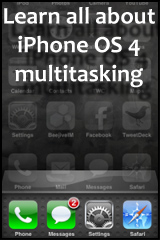Average user’s expectations for iOS 4 multitasking might be too high
by Justin Horn on Jun 10th, 2010 @ 4:58 pmBy naming these features “multitasking”, Apple has set customers’ expectations to include what apps can do in a traditional computer multitasking environment.
It’s going to mislead people into expecting such behavior from apps, but we can’t actually deliver most of it.
Some people will notice that no apps can do these things and properly focus their disappointment on Apple. But many others will only notice the shortcomings in one particular app that they need to do the “impossible” and blame that application, leading to dissatisfaction and negative thoughts about the app.
Marco uses his app, InstaPaper, as an example of these high expectations. He’s already received several request from users expecting the app to download articles in the background, without them having to open the app after the initial launch. It’s understandable for users expect this, but this is not how it works. Most apps will only be able to freeze their state so that you can resume right where you left off, but don’t actually function in the background. There are only specific task, like VoIP, that can actually work in the background and do “true multitasking”.
A couple months ago I wrote an article explaining in painful detail how the new multitasking features of iOS 4 will work (if you have 10 minutes to kill you should read the whole article). In it I highlight the same issue Marco brings ups:
For example, after leaving a Twitter app, it’s no longer updating your stream. When returning to the app, all the latest tweets will need to be downloaded. As most OS 4 compatible apps will fall into this category, it means push notifications are still going to play an important role in iPhone multitasking.
Macro proposes a solution to that would open up multitasking to many more apps:
The addition of one more multitasking service would solve this issue for a lot of application types: a periodic network request.
Basically allowing the system to manage requesting data for the app whenever it makes sense (depending on local resources, battery, etc.) and handing this data back to the app the next time it launches. I don’t believe Apple is done expanding on multitasking, but I have a feeling this is something Apple will relegate to push notifications.
I purpose a more hands on approach that can work within the current iOS 4 multitasking confines. The app would use local notifications to remind the user at a set interval to refresh their app’s data. The user then clicks ok on the notification and enters the app to begin downloading updates. They can immediately switch back to what they were doing while allowing the app to use task completion to finish up in the background. If the user is not concerned with updating the app they can ignore the notification and carry on with what they are doing. This way the user knows exactly what is being processed in the background and can keep better tabs on their usage and battery consumption. If you didn’t follow what I just said, you need to read my article on multitasking.
Follow me on Twitter @justin_horn
Comments Off
iOS 4, iPhone, iPod
Recent Post
- More details on the iPad mini new multitouch feature
- iPad Mini predictions
- Zune still the butt of jokes, this time on the Simpsons
- AT&T LTE No Service: Too many LTE iPhone 5 users?
- iPhone 5 cellular usage while on WIFI bug affects AT&T users as well
- Tim Cook responds to iOS 6 Map app issues in public letter
- iPhone 5 screen vs iPhone 4: Really close up
- iPhone 5 line at 5th Ave Apple Store (Updated 11PM)
Featured Post
Comments
Sorry, the comment form is closed at this time.


